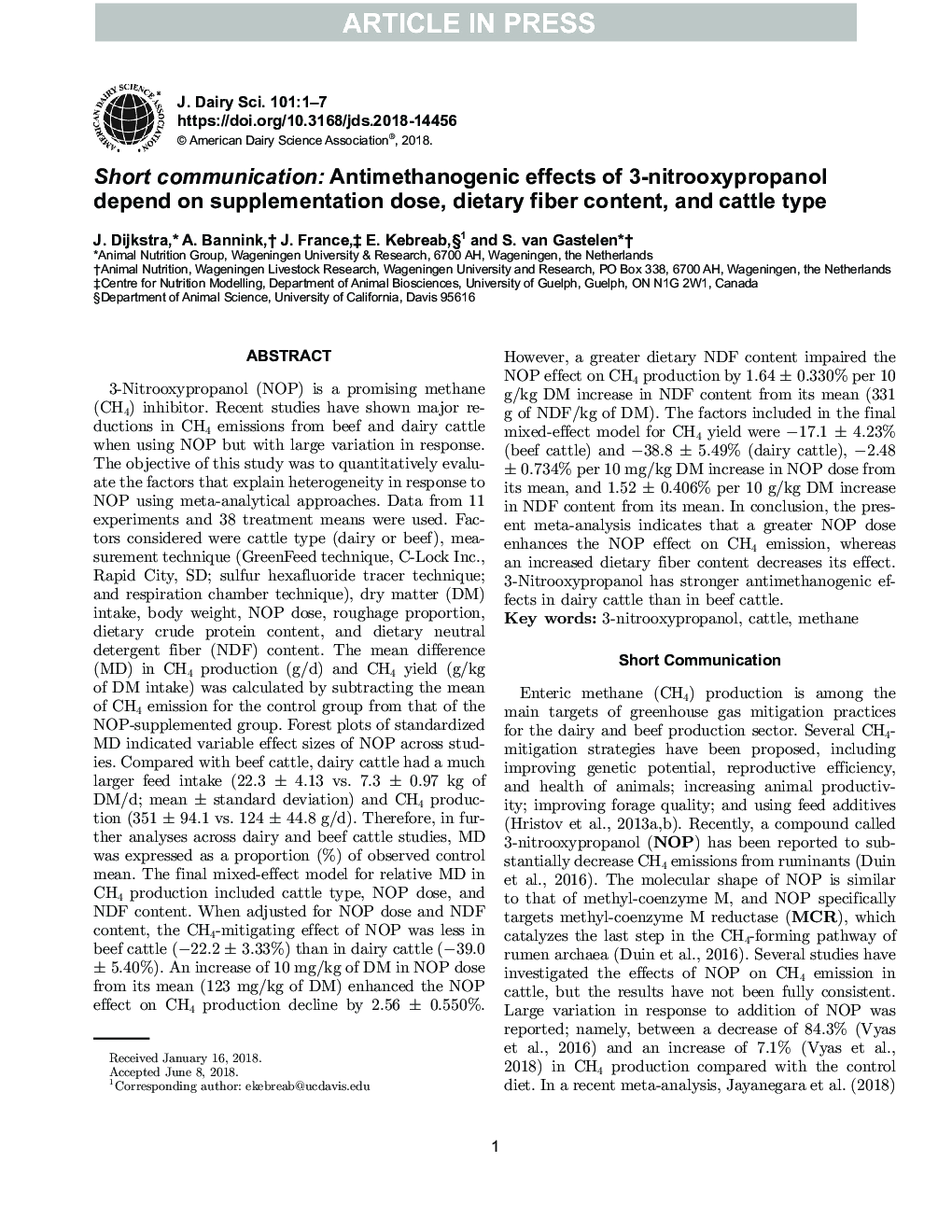| کد مقاله | کد نشریه | سال انتشار | مقاله انگلیسی | نسخه تمام متن |
|---|---|---|---|---|
| 10158068 | 1666505 | 2018 | 7 صفحه PDF | دانلود رایگان |
عنوان انگلیسی مقاله ISI
Short communication: Antimethanogenic effects of 3-nitrooxypropanol depend on supplementation dose, dietary fiber content, and cattle type
ترجمه فارسی عنوان
ارتباط کوتاه: اثرات آنتی مونوژنیک 3-نیتروکسی پروپانول بستگی به مقدار دوز مصرفی، محتوای فیبر رژیم غذایی و نوع گاو دارد.
دانلود مقاله + سفارش ترجمه
دانلود مقاله ISI انگلیسی
رایگان برای ایرانیان
کلمات کلیدی
3-نیتروکسی پروپانول، گاو متان،
موضوعات مرتبط
علوم زیستی و بیوفناوری
علوم کشاورزی و بیولوژیک
علوم دامی و جانورشناسی
چکیده انگلیسی
3-Nitrooxypropanol (NOP) is a promising methane (CH4) inhibitor. Recent studies have shown major reductions in CH4 emissions from beef and dairy cattle when using NOP but with large variation in response. The objective of this study was to quantitatively evaluate the factors that explain heterogeneity in response to NOP using meta-analytical approaches. Data from 11 experiments and 38 treatment means were used. Factors considered were cattle type (dairy or beef), measurement technique (GreenFeed technique, C-Lock Inc., Rapid City, SD; sulfur hexafluoride tracer technique; and respiration chamber technique), dry matter (DM) intake, body weight, NOP dose, roughage proportion, dietary crude protein content, and dietary neutral detergent fiber (NDF) content. The mean difference (MD) in CH4 production (g/d) and CH4 yield (g/kg of DM intake) was calculated by subtracting the mean of CH4 emission for the control group from that of the NOP-supplemented group. Forest plots of standardized MD indicated variable effect sizes of NOP across studies. Compared with beef cattle, dairy cattle had a much larger feed intake (22.3 ± 4.13 vs. 7.3 ± 0.97 kg of DM/d; mean ± standard deviation) and CH4 production (351 ± 94.1 vs. 124 ± 44.8 g/d). Therefore, in further analyses across dairy and beef cattle studies, MD was expressed as a proportion (%) of observed control mean. The final mixed-effect model for relative MD in CH4 production included cattle type, NOP dose, and NDF content. When adjusted for NOP dose and NDF content, the CH4-mitigating effect of NOP was less in beef cattle (â22.2 ± 3.33%) than in dairy cattle (â39.0 ± 5.40%). An increase of 10 mg/kg of DM in NOP dose from its mean (123 mg/kg of DM) enhanced the NOP effect on CH4 production decline by 2.56 ± 0.550%. However, a greater dietary NDF content impaired the NOP effect on CH4 production by 1.64 ± 0.330% per 10 g/kg DM increase in NDF content from its mean (331 g of NDF/kg of DM). The factors included in the final mixed-effect model for CH4 yield were â17.1 ± 4.23% (beef cattle) and â38.8 ± 5.49% (dairy cattle), â2.48 ± 0.734% per 10 mg/kg DM increase in NOP dose from its mean, and 1.52 ± 0.406% per 10 g/kg DM increase in NDF content from its mean. In conclusion, the present meta-analysis indicates that a greater NOP dose enhances the NOP effect on CH4 emission, whereas an increased dietary fiber content decreases its effect. 3-Nitrooxypropanol has stronger antimethanogenic effects in dairy cattle than in beef cattle.
ناشر
Database: Elsevier - ScienceDirect (ساینس دایرکت)
Journal: Journal of Dairy Science - Volume 101, Issue 10, October 2018, Pages 9041-9047
Journal: Journal of Dairy Science - Volume 101, Issue 10, October 2018, Pages 9041-9047
نویسندگان
J. Dijkstra, A. Bannink, J. France, E. Kebreab, S. van Gastelen,
